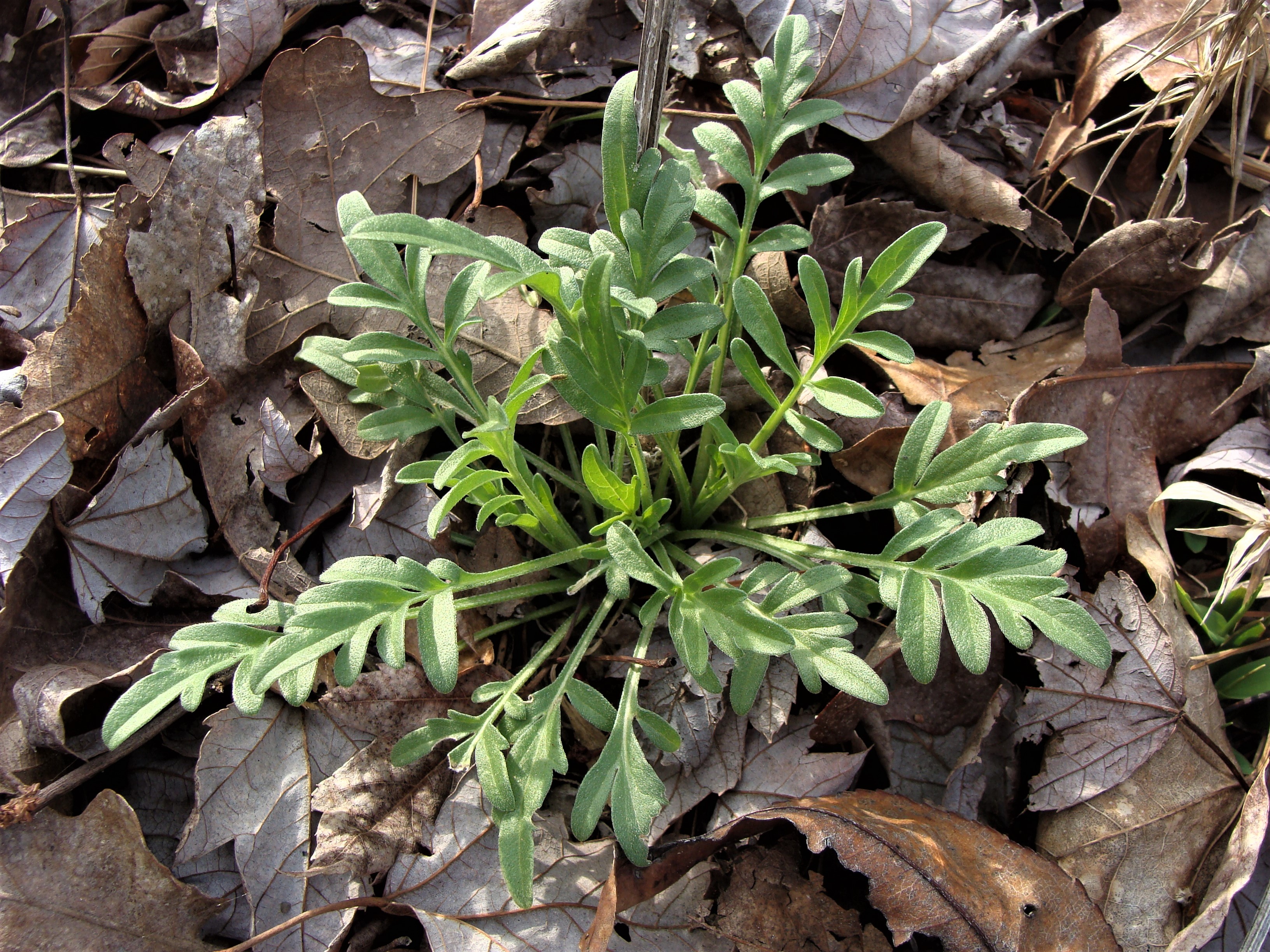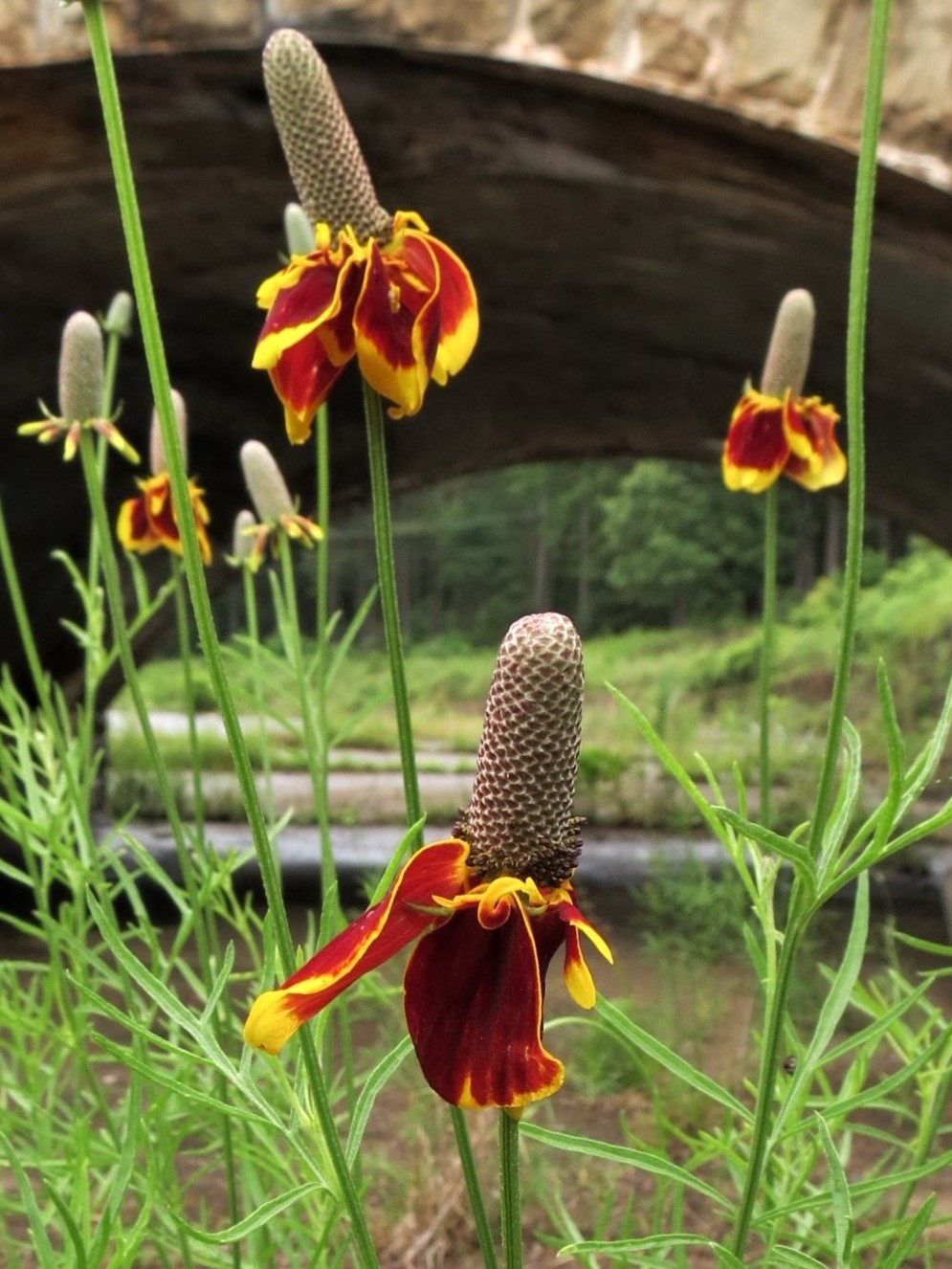Mexican Hat (Ratibida columnifera) of the Aster, Sunflower, or Composite (Asteraceae) family is a perennial species that has flowerheads with a columnar central receptacle (disk). The origin of the genus name, coined by the eccentric naturalist Constantine Rafinesque-Schmaltz, is not entirely clear, although it may be a modification of a first century name for an aster-like plant from an area that is now in Romania. The specific epithet translates to “in the shape of a column,” a reference to the central disk. The primary natural range of the species is believed to be a broad swath from northern and eastern Mexico to south-central Canada, that includes the Great Plains of the U.S., with additional widely scattered occurrences both eastward and westward to the Atlantic and Pacific Coasts. Some of these populations, especially nearer the core range, may be natural, but the species is widely cultivated as an ornamental, particularly in wildflower seed mixes, so the precise natural limits are obscured. In Arkansas, it is widely scattered across the state with the greatest concentrations in the Ozark Highlands and the southwest Blackland Prairie region. It may be indigenous to native grasslands in those areas, but is also often found along roadsides and other rights-of-way. Alternative common names include Long-Head Coneflower and Prairie Coneflower.
New spring growth arises from a smooth, yellow-tan, minimally branched taproot with numerous small secondary roots. Growth begins with one to several, early-deciduous, basal rosettes of leaves, that produce one to several, erect, sparsely branched stems, growing to 3 feet tall. Larger stems are ridged, becoming 4-5-sided. Minute strigose pubescence (short appressed hairs) gives them a rough feel. Plants have an open appearance due to leaf size decreasing distally. Dead stems persist well into the next year.



Basal and stem leaves are deeply pinnately incised with up to 15 mostly opposite, linear to linear-oblong lobes. A larger stem leaf may be 5 inches long and 3 inches wide with individual lobes to 2 inches long and 3/16 inch wide. Leaf number, size and lobing decrease distally––upper stems are leafless and uppermost leaves may consist of a single “lobe.” Lobes are apically rounded. Leaves are medium green on both surfaces with the proximal portion of the rachis trending to white. Other than midribs, venation is obscure. Like the stems, leaves are covered above and below with fine strigose pubescence and feel rough. Narrow wings extend along the rachis from the base of the lobes. While basal leaves have relatively long petioles, stem leaves become short-stalked to sessile.

The inflorescence, from late May into late July, consists of composite flowerheads at the tips of tough erect peduncles that may be several inches to a foot long. Heads consist of a central columnar disk to 2 inches long and ⅜ inch wide, with numerous disk florets, surrounded by 4 to 12 sterile ray florets (lacking stamens and pistils). The disk, before opening of its florets, has a patterned surface that is pale green to gray-green. Ray florets consist of round to ovate ligules with a notched apex and clawed base. They may be well-spaced to overlapping, becoming ruffled to misshapen when crowded. Plant-specific petal coloration varies from rich brownish reds with yellow borders to solid brownish red or solid yellow*. Heads have a variable number of tough lanceolate phyllaries (usually five) of various sizes that are ascending while the head is in bud, but become spreading at anthesis. Minute strigose pubescence that covers peduncles and phyllaries extends onto the central disk.


The several hundred closely spaced, spirally arranged disk florets reach anthesis in longitudinal “bands” from the disk base upwards. Calyxes (< 1/16 inch long), with a minute pedicel, comprise 5 pale green elongate sepals with knobbed apexes. A tight staminal column of five purple filaments (twice as long as the sepals) extend from each disk flower. Pollen-bearing anthers face inward. As the reddish purple style develops, it pushes through the staminal column and releases the pollen. After the pollen is displayed, the style branches and recurves to expose reddish purple, linear stigmatic surfaces.




Most disk florets do not seem to produce viable fruit. When fertilized, florets produce a flattened chevron-shaped achene to ⅛ inch long and half as wide. These elongate brown fruits have a rounded base and a flat apex which may have a pappus of 2 weak awns. Dispersal of seeds is probably by birds, gusty wind and surface-water flow.


With its colorful flowerheads and compact structure, Mexican Hat is commonly included in gardens, including native plant gardens. The plant prefers sunny sites with well drained soils, but will survive in partially shady sites and short-term dry conditions. Apparently it is not an aggressive self-seeder.
In addition to Mexican Hat, one additional member of the genus occurs in Arkansas, Gray-Head Coneflower (Ratibida pinnata). Gray-Head Coneflower is a taller plant with fibrous roots, leaves with broader lanceolate lobes, solid yellow ray flowers, and shorter, more rounded central disks.
*Some authorities identify plants with yellow ligules as R. columnifera forma columnifera and those with reddish brown ligules with yellow edges as R. columnifera forma pulcherrima.
Article and photographs by ANPS member Sid Vogelpohl

